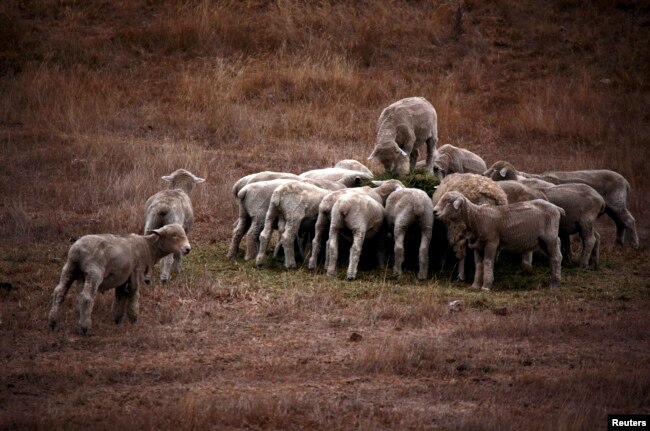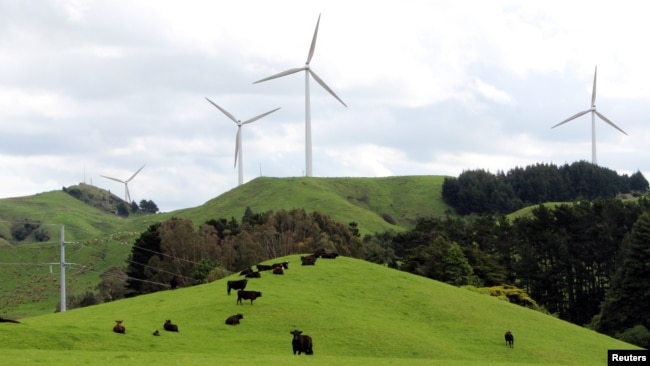NZ: 牛と羊の排出ガスに価格を設定
2017年37歳で首相就任したジャシンダ・アーダーン氏!!
世界で産休をとった初の首相。
2019年、ニュージーランド史上最悪のモスク銃撃事件に鮮やかな手腕で対処、犠牲者に寄り添い、
2020年、いちはやく新型コロナの封じ込めに成功!
VOAで英語を学びましょう!!
ニュージーランド、牛と羊の排出ガスに価格を設定か(和訳)
New Zealand May Put Price on Emissions from Cows and Sheep
June 12,2022
ニュージーランドは最近、農業活動から排出されるガスに価格をつけるという提案を発表しました。これは、同国最大の温室効果ガス発生源である羊と牛に対処するための努力の一環です。
二酸化炭素やメタンなどの温室効果ガスは、地球の大気中の温度を上昇させると考えられています。
環境省によれば、この措置によりニュージーランドは、家畜からの排出物を農家に負担させる最初の国になると言います。
500万人の人口を抱えるニュージーランドでは、約1000万頭の牛と2600万頭の羊が飼育されており、これらの家畜はメタンなどのガスを放出しています。
ニュージーランドの温室効果ガス総排出量の約半分は農業からのものです。しかし、これまで農業からの排出は、同国の排出量取引計画の一部には含まれていませんでした。このため、地球温暖化として知られる温室効果に歯止めをかけようとする政府の姿勢を批判する声も上がっていました。
政府と農業界の代表がまとめた計画の初期バージョンでは、2025年から農家はガスの排出量を支払わなければならなくなります。短い寿命の農業用ガスと長い寿命の農業用ガスは別々に価格設定されますが、その量を計算する尺度は1つに統一される予定です。
ジェームズ・ショー氏はニュージーランドの気候変動大臣です。
彼は、「大気中に放出されるメタンの量を削減する必要があることは間違いなく、農業に対する効果的な排出権取引制度は、それを達成する上で重要な役割を果たすでしょう。」と述べています。
この提案には、飼料添加物によって排出量を削減する農家へのインセンティブと、農場での林業によって排出量を補うことができることが含まれています。この計画で得た資金は、農家向けの研究開発および情報サービスに投資される予定です。
マイケル・アヒ氏は、気候変動対策団体 He Waka Eke Noa(ヘ・ワカ・エケ・ノア)の代表を務めています。アヒ氏はこの計画を、天然資源を完全に使い切ったり破壊したりしない方法を含むという意味で、サステナブル(持続可能)という言葉を使いました。
We are working together to implement a framework by 2025 to reduce agricultural greenhouse gas emissions and build the agriculture sector’s resilience to climate change.
農業による温室効果ガス排出を削減し、農業セクターの気候変動への耐性を高めるための枠組みを2025年までに実施するために、私たちは協力しています。
「私たちの提案は、将来の世代のために持続可能な食糧と繊維の生産を可能にすると同時に、我が国の気候変動に関する公約を満たすために公正な役割を果たすものです。」とアヒ氏は述べています。
ANZ銀行の農業経済学者であるスーザン・キルスビー氏は、この提案は1980年代に農業補助金が廃止されて以来、おそらく農業にとって最大の変化となるだろうと述べています。
この計画の最終決定は12月に行われる予定です。
New Zealand May Put Price on Emissions from Cows and Sheep
New Zealand recently released a proposal to put a price on gases released from agricultural activity. The move is part of an effort to deal with the country's biggest sources of greenhouse gases: sheep and cattle.
Greenhouse gases, including carbon dioxide and methane, are believed to cause warming temperatures in the Earth’s atmosphere.
The measure would make New Zealand the first country to have farmers pay for emissions from farm animals, the Ministry for Environment said.
New Zealand, home to 5 million people, has about 10 million cattle and 26 million sheep. These animals release gases such as methane.
Nearly half of New Zealand’s total greenhouse gas emissions come from agriculture. But agricultural emissions have previously not been part of the country's emissions trading plan. This has lead some to criticize the government's willingness to stop the greenhouse effect, known as global warming.
Under an early version of the plan, which was put together by government and farm community representatives, farmers will have to pay for their gas emissions starting in 2025. Short-and long-lived farm gas will be priced separately, although a single measure to calculate their volume will be used.
James Shaw is New Zealand’s Climate Change Minister.
He said, "There is no question that we need to cut the amount of methane we are putting into the atmosphere, and an effective emissions pricing system for agriculture will play a key part in how we achieve that."
The proposal includes incentives for farmers who reduce emissions through feed additives, while on-farm forestry can be used to make up for emissions. Money from the plan will be invested in research, development and information services for farmers.
Michael Ahie is chair of the climate action group He Waka Eke Noa. Ahie used the term sustainable, meaning involving methods that do not completely use up or destroy natural resources, to describe the plan.
"Our recommendations enable sustainable food and fiber production for future generations while playing a fair part in meeting our country's climate commitments," Ahie said.
The proposal would possibly be the biggest change to farming since the removal of agricultural subsidies in the 1980s, said Susan Kilsby, an agricultural economist at ANZ Bank.
A final decision on the plan is expected in December.
Words in This Story
emission – n. the act of producing or sending out something (such as energy or gas) from a source
calculate -- v. to find (a number, answer, etc.) by using mathematical processes
incentive – n. something that encourages a person to do something or to work harder
fiber – n. plant material that cannot be digested but that helps you to digest other food; a thin thread of natural or artificial material that can be used to make cloth, paper, etc.
subsidy – n. : money that is paid usually by a government to keep the price of a product or service low or to help a business or organization to continue to function

